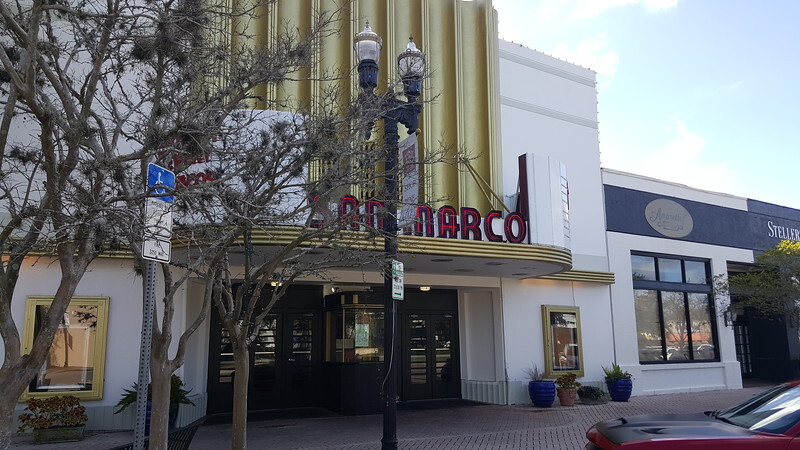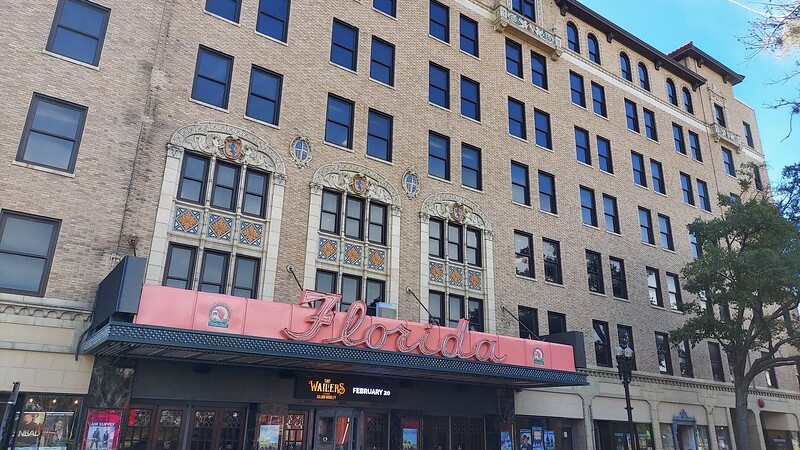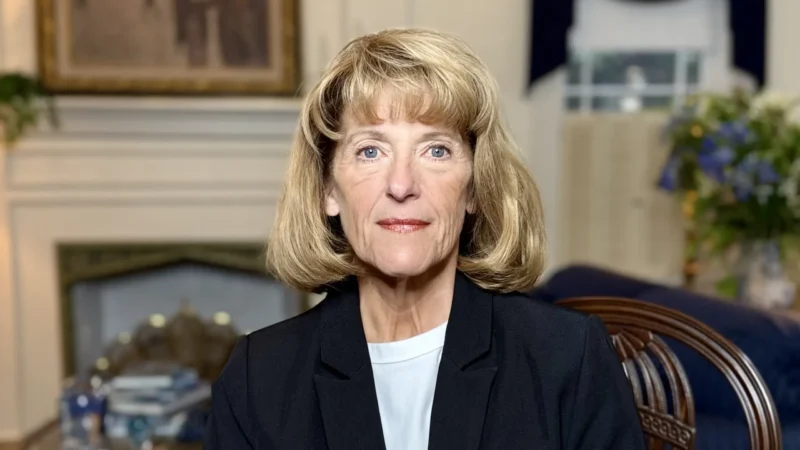
The Jaxson Magazine takes a look into the history of Jacksonville’s nine oldest surviving theaters.

Murray Hill Theatre (1949)
932 Edgewood Ave. S.
Designed by architect William Marshall, the Murray Hill Theatre opened its doors in August 1949. With Mayor Haydon Burns making an appearance, opening night guests paid 50 cents to see John Wayne and Montgomery Clift star in the classic Western film Red River. At the time a district with several specialty shops and grocery stores, Murray Hill’s Edgewood Avenue was known as the “Avenue of Progress.” By the 1990s, the theater had become an industrial goth club called The Dungeon. In 1995, the space was retrofitted into a Christian nightclub. Today, the Murray Hill Theatre is considered by many to be one of the nation’s top Christian rock venues.

Fairfax Theatre (1941)
4114 Herschel St.
Located at the intersection of Herschel Street and St. Johns Avenue, the Fairfax Theatre was completed in 1941. The 555-seat theater was designed by architect Roy A. Benjamin in the Art Moderne style. Long closed, the building has since been renovated into office and commercial space. Now owned by HTH Properties, current tenants include Bagel Love, Ortega Family Dental and Holland and Holland.

Brentwood Theatre (1941)
3725 N. Pearl St.
By the 1940s, North Pearl Street had evolved into a walkable neighborhood commercial district in the heart of Brentwood. In April 1941, the Brentwood Theatre opened its doors at the intersection of Pearl Street and West 28th Street near Andrew Jackson High School. Designed by Roy A. Benjamin and built by A. L. Clayton, the theater opened with Robert Ewing as the manager. For many years, the Art Moderne-style, one-screen theater was operated by Paramount Pictures, through its subsidiary E.J. Sparks. The theater closed its doors for good in the late 1950s. Today with its marquee still intact, the building serves as the Brentwood Branch Library of the Jacksonville Public Library system.

San Marco Theatre (1938)
1996 San Marco Blvd.
The San Marco Theater opened its doors on June 5, 1938, with Edward G. Robinson starring in A Slight Case of Murder for a fare of 30 cents. One of the most elegant vintage theaters in Jacksonville, the Art Deco style structure was designed by architect Roy A. Benjamin. A 500-seat single screen theater still in operation, it has been recognized as one of the 10 best classic cinemas in the country by USA Today.

Ritz Theatre (1929)
829 Davis St.
In September of 1929, Neil Witschen opened the Ritz Theater at the corner of State and Davis streets, just a few blocks north of Ashley Street. Designed in the Art Deco style by local architect Jefferson Powell, the one-screen, 970-seat theater quickly became LaVilla’s primary performance venue and an important stop on the Chitlin’ Circuit.
The Chitlin’ Circuit was the collective name given to a series of performance venues throughout the East, South, and upper Midwest areas of the country that were safe and acceptable for African American entertainers to perform in during segregation. Other notable venues on the Chitlin’ Circuit were the Cotton Club and Apollo Theater in Harlem, the Royal Peacock in Atlanta, the Fox Theatre in Detroit, and the Howard Theatre in Washington, D.C.
The Ritz closed its doors permanently in 1972. As a part of Mayor Ed Austin’s River City Renaissance Plan, the theater was largely demolished and renovated into a new theatre and museum behind the northwest corner marquee of the original building. The new Ritz Theatre opened on September 30, 1999.

Theatre Jacksonville/Little Theatre (1927)
2032 San Marco Blvd.
Funded by cigar magnate Carl S. Swisher, construction on San Marco’s Little Theatre building began in 1927. The theater building was designed by Ivan H. Smith, one of the founders of Reynolds, Smith & Hills. While constructed for the Little Theatre Co., which was founded in 1919, the venue did not stage its first performance until 1938. In 1969, the name of the company was changed to Theatre Jacksonville, Inc. In 1972, Mayor Hans Tanzler issued a proclamation identifying Theatre Jacksonville as the city’s “Official Theatre.” On July 11, 1991, the structure was added to the National Register of Historic Places. Today, Theatre Jacksonville is the nation’s oldest continuously operating community theater.

Florida Theater (1927)
128 E. Forsyth St.
Designed by architects Roy A. Benjamin and R.E. Hall & Co., Downtown Jacksonville’s Florida Theatre is one of the four last remaining high-style movie palaces constructed in Florida during the Mediterranean Revival architectural boom of the 1920s.
At the time of its opening on April 8, 1927, the seven-story theater was the largest in Florida. A performance by Elvis Presley in August 1956 made it a place of controversy, as a local judge threatened to arrest the musician for his negative influence on Jacksonville’s youth.
After a decade of decline during the 1970s, the Florida Theatre closed its doors in 1980. However, its historical significance resulted in the building’s being added to the National Register of Historic Places in 1982. After extensive renovations fueled with financial support from the state of Florida and the city of Jacksonville, the Florida Theatre reopened to the public in 1983. In 2021, the American Institute of Architects Florida Chapter placed the theater on its list of Florida Architecture: 100 Years. 100 Places.

Sun-Ray Theater (1927)
1028 Park St.
Anchoring Five Points, the Riverside Theater was designed by architect Roy A. Benjamin in the Italian Renaissance Revival style. When it opened in March 1927, it was the first in Florida and the third in the country constructed to show talking motion pictures. With an expensive ticket price of $1.10, Don Juan, starring John Barrymore and Mary Astor, was the first movie shown at the theater. In 1949, the building was remodeled and renamed the Five Points Theater. After closing in 1977, the space was a playhouse called the River City Playhouse between 1984 and 1991. During the 1990s and early 2000s, it was a popular nightclub called Club 5. In 2008, the building reopened as a movie theater. Renamed Sun-Ray Cinema in November 2011, the building also includes 14 loft condominiums on the third and fourth floors, office space on the second, and retail storefronts at street level.

Clara White Mission (1908)
615 W. Ashley St.
A fixture on Ashley Street since the Great Depression, the Clara White Mission building was originally constructed as the Bijou Theatre in 1908. Frank Crowd, a prominent barber and shooting gallery owner, opened the theater in 1908 with silent films as its primary attraction. However, competition from a nearby theater led to the Bijou’s closure in 1909.
Down but not out, Crowd invested $25,000 into his theater, adding new inclined floors, a balcony, private boxes and an all-tungsten lighting system. In 1910, he reopened as the Globe Theatre. In addition, the team of Rainey and Rainey joined Crowd’s Globe Stock Co. that January. At the time, Ma Rainey (Gertrude Pridgett Rainey) was one of the venue’s most popular musicians. She was known to receive three or four encores every night. By the end of her career, Ma Rainey had become billed as “The Mother of the Blues,” making several recordings with influential jazz figure Louis Armstrong. Jelly Roll Morton, the father of Jazz, also performed at the Globe on a regular basis during his brief time living in LaVilla.
During its heyday, the Globe was acknowledged as the anchor to the Southern road shows, and its Russell-Owens stock company was one of the most influential pioneering African-American theatrical stock companies in the country. The Great Migration and newer theatres in LaVilla eventually led to the Globe’s closure in 1916. In 1934, the vacant building became the new home of Eartha Mary Magdalene White’s Clara White Mission.
Eartha Mary Magdalene White, who sang as a lyric soprano as a cast member of John Ishma’s Oriental America, was a noted local humanitarian and civil rights activist. Notable guests and friends who visited the mission during White’s lifetime include Booker T. Washington, Mary McLeod Bethune, and Martin Luther King Jr. Dedicated in 1978, the Eartha M.M. White Memorial Art and Historical Resource Center is a museum on the second floor of the building that contains most of her furniture, objects, art and possessions.







